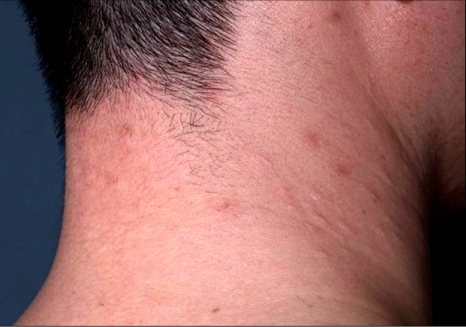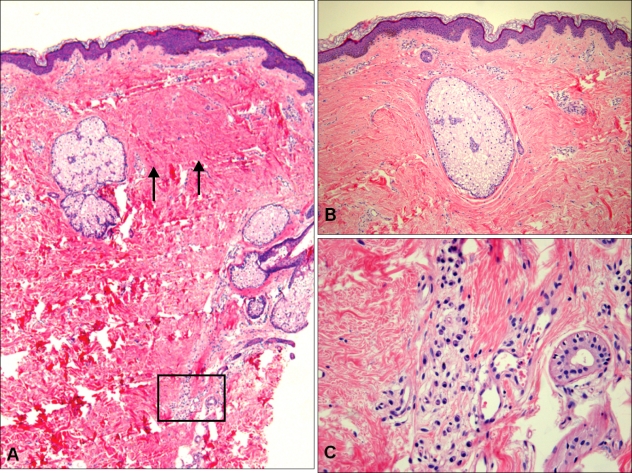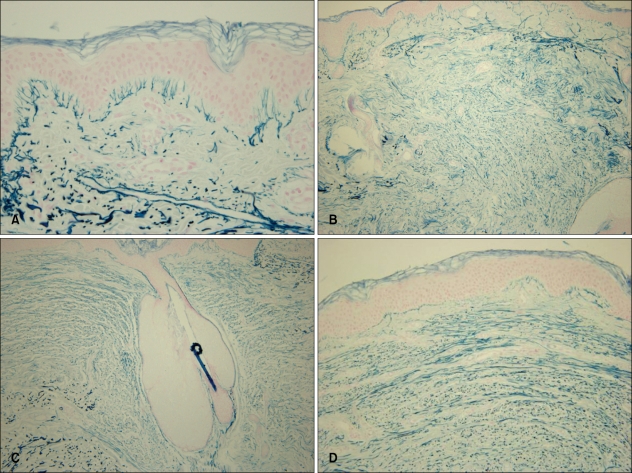Abstract
Fibroelastolytic papulosis of the neck (FEPN) encompasses a spectrum of two disorders that were previously reported as pseudoxanthoma elasticum-like papillary dermal elastolysis (PXE-PDE) and white fibrous papulosis of the neck (WFPN). The clinical presentation of FEPN is asymptomatic to mildly pruritic whitish-yellow papules that may coalesce into cobblestone patterned plaques that resemble pseudoxanthoma elasticum (PXE). The histology is characterized by a decrease or loss of elastic fibers in the papillary dermis and this is sometimes accompanied by a minimal or nodular increase of dermal collagen fibers. We report here on a 28-year-old Korean man with asymptomatic, multiple, skin-colored to slightly yellowish, match-head sized, cobblestone-patterned papules on the neck, and these were histologically consistent with FEPN and the papules showed slightly increased dermal collagen associated with decreased and fragmented elastic fibers, elastin and tropoelastin. The pathogenesis of FEPN in this case might have been related with mild dermal inflammation, followed by fragmentation, elastolysis and increased dermal collagen.
Keywords: Elastolysis, Fibroelastolytic papulosis
INTRODUCTION
Balus et al.1 first proposed the name "Fibroelastolytic papulosis of the neck (FEPN)" in 1997 and this included similar clinicopathological disorders such as pseudoxanthoma elasticum-like papillary dermal elastolysis (PXE-PDE) as reported by Rongioletti and Rebora2 in 1992 and white fibrous papulosis of the neck (WFPN) as reported by Shimizu et al.3 in 1989.
FEPN is a rare condition that has been documented in both women and men who are older than 40 years at the time of presentation. The pathogenesis of FEPN is unknown, though it is believed that FEPN is related to intrinsic aging. The clinical presentation of FEPN is asymptomatic to mildly pruritic whitish yellow papules that may coalesce into cobblestone patterned plaques that resemble PXE. The sites of involvement include the neck, supraclavicular region, scalp, axilla, lower abdominal region and antecubital fossa. The diagnostic histological findings are papillary dermal electrolysis with or without a dermal increase of collagen fibers. We report here on a rare case of FEPN in a 28-year-old young man who presented with the typical clinical and pathological features.
CASE REPORT
A 28-year-old Korean young man presented with asymptomatic, multiple, mildly pruritic, flesh-colored, match-head sized, cobblestone-patterned papules on the neck. This skin lesion first appeared approximately 13 years previously. He'd noted an increasing number of lesions and some of the lesions had become slightly itchy. The patient had no history of vascular, gastrointestinal or ocular disorders, but occasional chronic folliculitis had developed on the neck for many years. There was no family history of similar lesions. Physical examination demonstrated multiple 2 to 3 mm, discrete, skin colored to yellowish, match-head sized, cobblestone-patterned papules on the neck (Fig. 1). The cutaneous examination was otherwise unremarkable. Funduscopic evaluation did not reveal angioid streaks or other abnormalities. There were no specific lab findings. The histological sections from the neck lesion revealed focal, nodular, slightly increased collagen fibers, and these fibers presented as a focal sclerotic area in the upper and mid reticular dermis (Fig. 2A) and increased sclerosis due to the increased dermal collagen was observed around the sebaceous glands (Fig. 2B). There was no upper dermal perivascular infiltration of inflammatory cells. An incidental finding was an infiltration of a few lymphocytes and plasma cells in the deep dermis, which might have been related with skin adnexa (Fig. 2C). Focal loss of oxytalan fibers was noted just above the dermal sclerotic area. The elastic fibers were significantly decreased and fragmented in the upper and mid dermis (Fig. 3A, B), as compared with that in the surrounding dermis. Immunohistochemical staining for elastin (Clone BA-4, 1:100, Abcam, Cambridge, UK) and tropoelastin (Clone T11E3, 1:500, Abcam, Cambridge, UK) was also decreased and there was fragmented elastin and tropoelastin in the mid dermis (Fig. 3C, D). With the clinicopathological correlation, the diagnosis was made as FEPN. The patient is currently under follow-up with no specific treatment.
Fig. 1.
Asymptomatic, multiple, yellowish to skin colored, match-head sized, cobblestone-patterned papules on the neck of a 28-year-old man. The lesions were more prominently observed when the head was rotated.
Fig. 2.
(A) Histology of the papular skin lesion showed nodular increased dermal collagen in the upper dermis (arrow) with a focal inflammatory reaction (rectangle) in the lower dermis (H&E, ×40). (B) Dermal sclerosis due to the increased collagen around the sebaceous gland in the mid dermis (H&E, ×100). (C) The high power view of a rectangular area in (A) showed a few lymphocytes and plasma cells in the periadnexa (H&E, ×200).
Fig. 3.
(A) Verhoeff elastic stain shows decreased elastic fibers in the upper and mid dermal areas (Verhoeff elastic stain, ×100). (B) Victoria blue elastic stain shows decreased and fragmented elastic fibers in the dermis (Victoria blue elastic stain, ×200). (C) Immunohistochemical staining for the elastic fibers shows decreased and fragmented elastic fibers in the dermis (Immunoperoxidase staining with anti-elastic fiber antibody, ×200). (D) Immunohistochemical staining for tropoelastin shows these are decreased and fragmented in the dermis (Immunoperoxidase stain with anti-tropoelastin antibody, ×200).
DISCUSSION
In 1989, Shimizu et al.3 described 32 elderly patients with isolated, whitish papules over the back of the neck, and he termed this as "white fibrous papulosis of the neck". The lesions were characterized histologically by fibrosis of the papillary dermis and in some cases, mild alterations of the elastic fiber network. A few years later, a similar entity was reported by Rongioletti and Rebora2, who described two cases of acquired elastolysis of the papillary dermis that simulated PXE without fibrotic change. This condition consisted of confluent, yellowish papules that formed cobblestone plaques on the necks of the two elderly women. Yet many previously published studies support the theory that WFPN and PXE-PDE are variants of a single disorder1,4,5. The latter is different from PXE histologically by the diffuse changes of wavy, irregularly shaped and granular elastic fibers with calcium deposition in the reticular dermis. Balus et al.1 first proposed the name "fibroelastic papulosis of the neck" in 1997 because the two entities are similar for the pathological presentation, which is characterized by focal fibrosis and loss of elastic fibers in the upper reticular and papillary dermis. But there are several clinical differences between WFPN and PXE-PDE. WFPN is characterized by isolated, whitish papules in patients who are 39~80 years of age, this is mainly found in Japanese males and rarely in European females, while those papules of PDE are yellowish and they often coalesce to form cobblestone plaque in females who are 63~80 years of age. The major histological feature of WFPN is a papillary dermal fibrosis with few elastic fibers, while PXE-PDE shows papillary dermal electrolysis without dermal fibrosis. However, there is considerable overlap between the clinical and histological features of these two entities1. Our case was a Korean young man with multiple yellowish to skin colored papules with a cobble stone appearance, the histology was similar to that of WFPN and it showed dermal fibrosis and decreased elastic fibers.
The pathogenesis of FEPN has been suggested to be a manifestation of intrinsic aging5 because FEPN develops in older persons with no inflammatory process6,7. The immunohistochemical study of the neck skin from 4 Japanese patients with PXE-PDE, along with both aged and young healthy control subjects, showed the absence of elastin and fibrillin-1 in the papillary dermis of the affected individuals, the absence of fibrillin-1, but normal elastin in the aged control subjects, and intact staining for both elastin and fibrillin-1 in the younger control subjects8. Fibrillin-1 is absent and elastin is decreased in the papillary dermis of photoaged skin with solar elastosis9, suggesting that a photoaging mechanism is related in some cases.
We think that the intrinsic aging mechanism is not a sufficient explanation for FEPN in this case. We suggest that mild folliculitis or adnexal inflammation might be related to the pathogenesis of FEPN on the basis of the following clinicopathological findings. This case developed on the neck of a 28-year-old young man with history of mild folliculitis for many years. Decreased numbers of oxytalan and elastic fibers were noted at the same location as the dermal fibrosis, suggesting that the local elastolysis was associated with dermal fibrosis. Fibrosis surrounding the sebaceous glands was noted in the deeper sequential sections. Incidentally noted was the infiltration of a few lymphocytes and plasma cells in the deep dermis, which might be related with folliculitis or sweat gland inflammation.
Immunohistochemical study for elastin and tropoelastin showed decreased amounts in the nodular fibrotic area in the upper dermis, as well as in the dermal-epidermal junction. These histological findings suggested, although not conclusively, that the FEPN in this case might be related with the inflammatory process of skin adnexa, followed by dermal fibrosis and the loss of elastic fibers.
Many differential diagnoses exist for FEPN and they can be differentiated according to the clinicopathological findings. The most common differential diagnosis of FEPN is PXE1. PXE presents with skin lesions that may be similar in appearance to that of FEPN. The onset of PXE is usually evident by the second decade of life. In addition to skin papules, a major differentiating factor between the two is that the patients with PXE can have gastrointestinal, ocular and cardiovascular involvement, with angioid streaks being found almost universally in adults with PXE. In the lesional skin from patients with PXE, there is typical granular degeneration of the dermal elastic fibers on the elastic stains, and the ultrastructural appearance of the elastic fibers is strikingly different from that of FEPN10. Other differential diagnoses include late-onset focal dermal elastosis11, acquired middermal elastolysis12, eruptive connective tissue nevi, dermatofibrosis lenticularis disseminata, eruptive xanthoma, trichodiscomas, juxtaclavicular beaded lines13, amyloid elastosis14 and lichen myxedematosus. The histological hallmark of FEPN is the absence or marked decrease of elastic tissue in the papillary dermis with or without dermal fibrosis. But not all the lesional skin demonstrates the characteristic absence of elastic fibers in the papillary dermis15. Therefore, in some instances, multiple biopsy specimens may be necessary to make a diagnosis because of the lack of uniformity in the histology. Ultrastructural studies can be also helpful to understand the histopathological mechanisms of FEPN. The broad term 'fibroelastic papulosis' (FEP) is more appropriate than FEPN because FEP can occur in other sites as well.
To date, no successful treatments have been reported for FEPN, PXE-PDE or WFPN. One hypothetic therapeutic approach could be to administer topical antioxidant to inhibit the intrinsic free-radical induced aging.
References
- 1.Balus L, Amantea A, Donati P, Fazio M, Giuliano MC, Bellocci M. Fibroelastolytic papulosis of the neck: a report of 20 cases. Br J Dermatol. 1997;137:461–466. [PubMed] [Google Scholar]
- 2.Rongioletti F, Rebora A. Pseudoxanthoma elasticum-like papillary dermal elastolysis. J Am Acad Dermatol. 1992;26:648–650. doi: 10.1016/s0190-9622(08)80797-9. [DOI] [PubMed] [Google Scholar]
- 3.Shimizu H, Kimura S, Harada T, Nishikawa T. White fibrous papulosis of the neck: a new clinicopathologic entity? J Am Acad Dermatol. 1989;20:1073–1077. doi: 10.1016/s0190-9622(89)70135-3. [DOI] [PubMed] [Google Scholar]
- 4.Pirard C, Delbrouck-Poot F, Bourlond A. Pseudoxanthoma-elasticum-like papillary dermal elastolysis: a new case. Dermatology. 1994;189:193–195. doi: 10.1159/000246831. [DOI] [PubMed] [Google Scholar]
- 5.Rongioletti F, Rebora A. Fibroelastolytic patterns of intrinsic skin aging: pseudoxanthoma-elasticum-like papillary dermal elastolysis and white fibrous papulosis of the neck. Dermatology. 1995;191:19–24. doi: 10.1159/000246478. [DOI] [PubMed] [Google Scholar]
- 6.Akagi A, Tajima S, Kawada A, Ishibashi A. Coexistence of pseudoxanthoma elasticum-like papillary dermal elastolysis and linear focal dermal elastosis. J Am Acad Dermatol. 2002;47:S189–S192. doi: 10.1067/mjd.2002.108495. [DOI] [PubMed] [Google Scholar]
- 7.Tajima S, Ohnishi Y, Akagi A, Sasaki T. Elastotic change in the subpapillary and mid-dermal layers in pseudoxanthoma elasticum-like papillary dermal elastolysis. Br J Dermatol. 2000;142:586–588. doi: 10.1046/j.1365-2133.2000.03399.x. [DOI] [PubMed] [Google Scholar]
- 8.Ohnishi Y, Tajima S, Ishibashi A, Inazumi T, Sasaki T, Sakamoto H. Pseudoxanthoma elasticum-like papillary dermal elastolysis: report of four Japanese cases and an immunohistochemical study of elastin and fibrillin-1. Br J Dermatol. 1998;139:141–144. doi: 10.1046/j.1365-2133.1998.02332.x. [DOI] [PubMed] [Google Scholar]
- 9.Dahlback K, Ljungquist A, Lofberg H, Dahlback B, Engvall E, Sakai LY. Fibrillin immunoreactive fibers constitute a unique network in the human dermis: immunohistochemical comparison of the distributions of fibrillin, vitronectin, amyloid P component, and orcein stainable structures in normal skin and elastosis. J Invest Dermatol. 1990;94:284–291. doi: 10.1111/1523-1747.ep12874430. [DOI] [PubMed] [Google Scholar]
- 10.Contri MB, Boraldi F, Taparelli F, De Paepe A, Ronchetti IP. Matrix proteins with high affinity for calcium ions are associated with mineralization within the elastic fibers of pseudoxanthoma elasticum dermis. Am J Pathol. 1996;148:569–577. [PMC free article] [PubMed] [Google Scholar]
- 11.Tajima S, Tanaka N, Ohnishi Y, Ishibashi A, Kajiya H, Osakabe T, et al. Analysis of elastin metabolism in patients with late-onset focal dermal elastosis. Acta Derm Venereol. 1999;79:285–287. doi: 10.1080/000155599750010670. [DOI] [PubMed] [Google Scholar]
- 12.Perrin C, Castanet J, Lacour JP, Michiels JF. White papulosis of the neck. Clinical aspects of pseudoxanthoma elasticum. Ann Dermatol Venereol. 1996;123:114–117. [PubMed] [Google Scholar]
- 13.Finan MC, Apgar JT. Juxta-clavicular beaded lines: a subepidermal proliferation of sebaceous gland elements. J Cutan Pathol. 1991;18:464–468. doi: 10.1111/j.1600-0560.1991.tb01386.x. [DOI] [PubMed] [Google Scholar]
- 14.Vecchietti G, Masouye I, Salomon D, Dozier C, Saurat JH, Helg C, et al. An unusual form of primary systemic amyloidosis: amyloid elastosis: report of a case treated by haematopoietic cell transplantation. Br J Dermatol. 2003;148:154–159. doi: 10.1046/j.1365-2133.2003.05036.x. [DOI] [PubMed] [Google Scholar]
- 15.Jagdeo J, Ng C, Ronchetti IP, Wilkel C, Bercovitch L, Robinson-Bostom L. Fibroelastolytic papulosis. J Am Acad Dermatol. 2004;51:958–964. doi: 10.1016/j.jaad.2004.06.038. [DOI] [PubMed] [Google Scholar]





